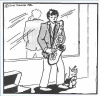Tuesday, October 31, 2006
Maurice Sendak Exhibition
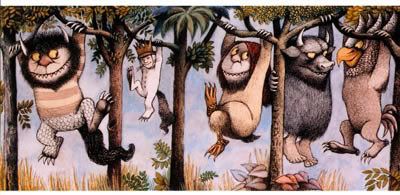 On Sunday, we went to the Where The Wild Things Are: Maurice Sendak In His Own Words and Pictures exhibition, at the Jewish Museum in St. Kilda. This exhibition was in its last day (it ran since July), so we had left it pretty late :).
On Sunday, we went to the Where The Wild Things Are: Maurice Sendak In His Own Words and Pictures exhibition, at the Jewish Museum in St. Kilda. This exhibition was in its last day (it ran since July), so we had left it pretty late :).While it was a fine retrospective, I must admit to being a bit disappointed by the lack of finished original artwork. In fairness, a number of pieces had been removed from show, so these may have been among them, and also this wasn't really the expressed intention of the exhibition:
"An exhibition for people of all ages, a hands-on interaction with Sendak's stories and characters. Dress up like a Wild Thing, dance in the wild forest, cook in the Night Kitchen, read on Rosie's stoop, slide into a bowl of chicken soup, and create your own masterpieces while listening to classical music. The "voice" of the exhibition is Sendak himself and focuses on his lifework through the lens of his Jewish heritage."
The Maurice Sendak exhibition was "organised by The Breman Museum, Atlanta, GA. Many of the images in this exhibition are facsimiles taken from the original art in the Maurice Sendak Archive housed at the Rosenbach Museum and Library, Philadelphia, PA."
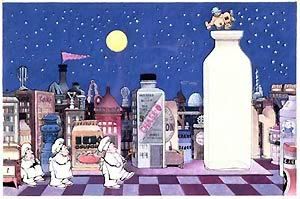 The activities and displayed artwork were well organised, and there were many original pages of writing and some original sketches from notebooks in the cases. My major frustration was the size of the reproductions, which I felt misinformed viewers about the artist's working methods. These high quality facsimiles included complete layouts of pages, displaying the blue pencil line borders, black inkwork and even the pasted up type, but at a smaller size than the original. Most of the reproductions of finished illustrations were at the same, or a smaller size, than in the books themselves. I would have liked the method of watercolour and acetate overlay on Night Kitchen made more clear, but was overjoyed to see that Winsor McCay's Little Nemo in Slumberland was displayed alongside, with clear recognition of the tribute Sendak was paying in his classic book.
The activities and displayed artwork were well organised, and there were many original pages of writing and some original sketches from notebooks in the cases. My major frustration was the size of the reproductions, which I felt misinformed viewers about the artist's working methods. These high quality facsimiles included complete layouts of pages, displaying the blue pencil line borders, black inkwork and even the pasted up type, but at a smaller size than the original. Most of the reproductions of finished illustrations were at the same, or a smaller size, than in the books themselves. I would have liked the method of watercolour and acetate overlay on Night Kitchen made more clear, but was overjoyed to see that Winsor McCay's Little Nemo in Slumberland was displayed alongside, with clear recognition of the tribute Sendak was paying in his classic book.In terms of the work covered, the range went from Sendak's beginnings (and various continuing inspirations, both thematically and artistically), his work as an illustrator for other writers, his own first work (Where the Wild Things Are, which grew from Where the Wild Horses are) and many brilliant books, his illustration of classic works, his work design work for film, theatre and television, and the adaptations of Sendak's own work in various forms. The use of multimedia (particularly interviews and films such as The Sign on Rosie's Door, with music by Carole King) was well integrated. There was some focus on the fascinating theatrical background of Brundibar, also the final book Sendak illustrated.
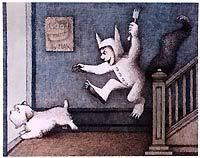 Some of the emphasis was different than I might have expected, with the first two parts of Sendak's classic trilogy, Wild Things and In the Night Kitchen, well represented, but Outside Over There largely passed over for display in favour of the illustrated version of the "found" Grimm story, Dear Mili.
Some of the emphasis was different than I might have expected, with the first two parts of Sendak's classic trilogy, Wild Things and In the Night Kitchen, well represented, but Outside Over There largely passed over for display in favour of the illustrated version of the "found" Grimm story, Dear Mili.Notably missing for me was Sendak's own Higglety Pigglety Pop! Or There Must Be More to Life, a tribute to Jennie, his Sealyham terrier. Of Sendak's work for other writers, some of my favourites that didn't appear at all were Charlotte Zolotow's Mr. Rabbit and the Lovely Present, Sesyle Joslin's What Do You Say, Dear? and What Do You Do, Dear? and Doris Orgel's Rosie's Room. Else Holme Minarik's Little Bear books and Sendak's inspired Hector Protector were at least in the stack of books there for reading. All are highly recommended for reading to your kids! I really should put some more pictures...
All this is nit-picking on my part. Maurice Sendak is surely one of the finest artists to ever work in children's books, and this exhibition was a good introduction to his work, particularly for children.
For people interested, particularly if you don't already know Maurice Sendak's work, please check out the Media Resources page.
Also highly recommended are Selma Lane's The Art of Maurice Sendak and Tony Kushner's more recent The Art of Maurice Sendak: 1980 to Present.
Labels: Maurice Sendak
Saturday, October 21, 2006
Heroes & Villains Comics Exhibition
 Last night, I went to the official launch of Heroes and Villains: Australian Comics and their Creators at the State Library of Victoria. It was a great launch, with a fine speech from State Librarian, Ann Marie Schwirtlich, and entertainment from comedy band Tripod, and a nice chance to catch up with various comickers and librarians alike.
Last night, I went to the official launch of Heroes and Villains: Australian Comics and their Creators at the State Library of Victoria. It was a great launch, with a fine speech from State Librarian, Ann Marie Schwirtlich, and entertainment from comedy band Tripod, and a nice chance to catch up with various comickers and librarians alike. The above link is to the online version of the Exhibition Catalogue, including a detailed essay by exhibition curator and Australian comics expert, Kevin Patrick, charting the history of Australian comic books, from the 1920s to the 21st century.
It was pleasing to find my 1982 comic Maelstrom in the Swords & Sorcery section, right alongside Talnon's Deerflame. The detailed sections covering each genre of Australian comics were really thought-out, well-researched and arranged. There's a mention of Maelstrom in the Exhibition catalogue Swords & Sorcery section, though I think too much is made of the Elfquest link in some respects, given that I did a Maelstrom minicomic back in 1978 (before EQ) - but more on that in another post...
For more information on seminars, workshops and multimedia events being staged for the duration of the exhibition (20 Oct 2006 - 25 Feb 2007) - please see: Program of Events.
Labels: Australian comics, Maelstrom
Tuesday, October 17, 2006
Stanley Awards 2006
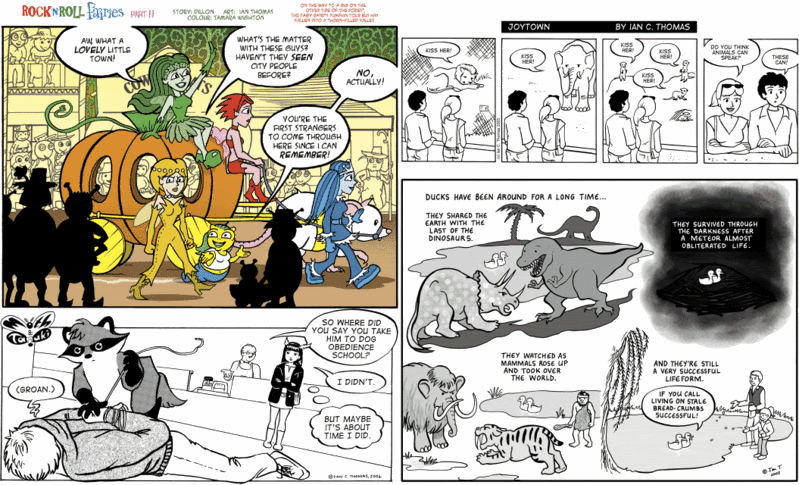
Yesterday I received my copy of the Stanleys Yearbook. The cover this year is gorgeous (sorry, no scan) and there's not long for members of the Australian Cartoonists' Association to vote before the presentations in Ballarat in early November.
Here's my entry in the Yearbook, which covers a bit of what I've been up to during the past year (yes, some pieces have older dates, but all saw publication in print during the July 2005-June 2006 period). Sorry it's not that legible: it is in the book and I wanted to make maximum use of the allocated space. Most of these should be familiar anyway :).
Last year's entry is still viewable on my member's page at the ACA - Ian Thomas - but not for much longer!
Labels: Stanley Awards
Sunday, October 15, 2006
New animals and birds in 2006!
This post has been sitting for a while as I seem to keep needing to add new discoveries to it.
This year has been another fine one for crytozoology, with naturalists batting above the annual average of three new bird species discoveries worldwide - we're already well ahead. Among the mammals there are quite a few new ones, with some from unexpected locations, plus the rediscovery and tagging of a Cuban solenodon (one strange beast, that!), thought extinct. Among mammals last year, there were two new mouse lemurs from Madagascar, and the Australian snubfin dolphin.
12 October 2006
 "Big headed 'prehistoric mouse' is alive in Europe"
"Big headed 'prehistoric mouse' is alive in Europe"
First off is the Cypriot mouse. (New Scientist)
"A new species of mammal – a mouse with unusually large ears and eyes – has been discovered on the Mediterranean island of Cyprus... In fact, the genetic evidence shows it to be an "ancient relic", closer to its prehistoric ancestor than any modern cousin."
(National Geographic News covers most of the recent bird discoveries, but I've noted sources and linked. Of course, these discoveries are most often a sign that we're exploring the world's last wildernesses, but possibly it's better to do this than log them first (which is a real possibility in many of these areas).
10 October 2006
 New bird discovered in Columbia (National Geographic)
New bird discovered in Columbia (National Geographic)
"The fist-size bird with punk-rock plumage is a new-and possibly threatened-avian species that makes its home in the last remnants of a remote Colombian cloud forest. Dubbed the Yariguíes brush finch, the small bird was first found in 2004 in an isolated region of the eastern Andes mountain range known as the Serranía de los Yariguíes."
September 30, 2006
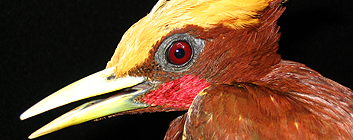 Amazon explorers discover 40 new species in a 'lost world' of rainforest (Times Online, pic from Zaxy Wordpress)
Amazon explorers discover 40 new species in a 'lost world' of rainforest (Times Online, pic from Zaxy Wordpress)
"Up to 40 new species of plants and animals, including a bird and a tree rat, have been discovered in an expedition to one of the world’s last unspoilt wildernesses... Besides the rat and the bird, the new species found include seven fish, eight frogs, lizards and snakes, two shrimps and eight plants... The tree rat, from the genus makalata and the size of a large guinea-pig, lives with monkeys in the trees of the Amazonian tropical forest, where it eats only leaves and fruit."
12 September 2006
 New bird discovered in India (National Geographic)
New bird discovered in India (National Geographic)
"Named Bugun liocichla, the small bird is described as a type of babbler, a diverse family of birds that usually live in tropical forests."
7 February 2006
 ""Lost World" Found in Indonesia (Foja Mountains, New Guinea) Is Trove of New Species (National Geographic)
""Lost World" Found in Indonesia (Foja Mountains, New Guinea) Is Trove of New Species (National Geographic)
"Within minutes of landing, the scientists encountered a bizarre, orange-faced honeyeater bird (see photo). It proved to be a new bird species, the first discovered in New Guinea since 1939. On the second day the lakebed group made another suprising find when a male and female Berlepsch's six-wired bird of paradise came into the camp to perform a mating dance. Until now the homeland of this "lost" bird had been unknown. It was the first time Western scientists had even seen an adult male." Also found were the rare golden-mantled tree kangaroo and 20 new species of frogs, along with 150 new insects and 550 new plants.
This year has been another fine one for crytozoology, with naturalists batting above the annual average of three new bird species discoveries worldwide - we're already well ahead. Among the mammals there are quite a few new ones, with some from unexpected locations, plus the rediscovery and tagging of a Cuban solenodon (one strange beast, that!), thought extinct. Among mammals last year, there were two new mouse lemurs from Madagascar, and the Australian snubfin dolphin.
12 October 2006
 "Big headed 'prehistoric mouse' is alive in Europe"
"Big headed 'prehistoric mouse' is alive in Europe"First off is the Cypriot mouse. (New Scientist)
"A new species of mammal – a mouse with unusually large ears and eyes – has been discovered on the Mediterranean island of Cyprus... In fact, the genetic evidence shows it to be an "ancient relic", closer to its prehistoric ancestor than any modern cousin."
(National Geographic News covers most of the recent bird discoveries, but I've noted sources and linked. Of course, these discoveries are most often a sign that we're exploring the world's last wildernesses, but possibly it's better to do this than log them first (which is a real possibility in many of these areas).
10 October 2006
 New bird discovered in Columbia (National Geographic)
New bird discovered in Columbia (National Geographic)"The fist-size bird with punk-rock plumage is a new-and possibly threatened-avian species that makes its home in the last remnants of a remote Colombian cloud forest. Dubbed the Yariguíes brush finch, the small bird was first found in 2004 in an isolated region of the eastern Andes mountain range known as the Serranía de los Yariguíes."
September 30, 2006
 Amazon explorers discover 40 new species in a 'lost world' of rainforest (Times Online, pic from Zaxy Wordpress)
Amazon explorers discover 40 new species in a 'lost world' of rainforest (Times Online, pic from Zaxy Wordpress)"Up to 40 new species of plants and animals, including a bird and a tree rat, have been discovered in an expedition to one of the world’s last unspoilt wildernesses... Besides the rat and the bird, the new species found include seven fish, eight frogs, lizards and snakes, two shrimps and eight plants... The tree rat, from the genus makalata and the size of a large guinea-pig, lives with monkeys in the trees of the Amazonian tropical forest, where it eats only leaves and fruit."
12 September 2006
 New bird discovered in India (National Geographic)
New bird discovered in India (National Geographic)"Named Bugun liocichla, the small bird is described as a type of babbler, a diverse family of birds that usually live in tropical forests."
7 February 2006
 ""Lost World" Found in Indonesia (Foja Mountains, New Guinea) Is Trove of New Species (National Geographic)
""Lost World" Found in Indonesia (Foja Mountains, New Guinea) Is Trove of New Species (National Geographic)"Within minutes of landing, the scientists encountered a bizarre, orange-faced honeyeater bird (see photo). It proved to be a new bird species, the first discovered in New Guinea since 1939. On the second day the lakebed group made another suprising find when a male and female Berlepsch's six-wired bird of paradise came into the camp to perform a mating dance. Until now the homeland of this "lost" bird had been unknown. It was the first time Western scientists had even seen an adult male." Also found were the rare golden-mantled tree kangaroo and 20 new species of frogs, along with 150 new insects and 550 new plants.
Labels: cryptozoology, new animals, new birds, new species
Thursday, October 12, 2006
Trouble for Illustration Friday

The first thing that popped into my head for this Illustration Friday topic was to draw one of our iconic Australian mischief making kids, such as Ginger Meggs or Blinky Bill the koala. I'd been meaning to get to this all week, but finally sat down tonight and sketched this (very quickly). This is Ginger Meggs in the traditional Bancks look - Ginger accompanied by Tony, the monkey, and Mike, the dog.
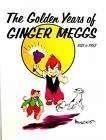 Last week I picked up a book as a library discard - The Golden Years of Ginger Meggs, 1921-1952 - a huge tome that gathers together many of Bancks full-page strips. Full page funnies are of particular interest to me at present and Bancks mastery of this form is quite amazing.
Last week I picked up a book as a library discard - The Golden Years of Ginger Meggs, 1921-1952 - a huge tome that gathers together many of Bancks full-page strips. Full page funnies are of particular interest to me at present and Bancks mastery of this form is quite amazing.Ginger Meggs is still going strong, currently (and continuously since 1984) drawn by top Australian cartoonist James Kemsley - see the Ginger Meggs site, for current strips, history, etc. The Kemsley Ginger Meggs books, which telling traditional Meggs tales in prose and picture format, are also highly recommended!
Labels: Illustration Friday
